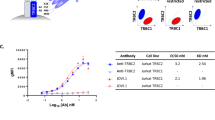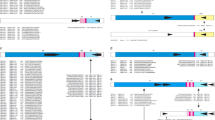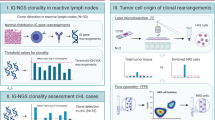Abstract
Molecular analysis of T cell receptor (TCR) genes is frequently used to prove or exclude clonality and thereby support the diagnosis of suspect T cell proliferations. PCR techniques are more and more being used for molecular clonality studies. The main disadvantage of the PCR-based detection of clonal TCR gene rearrangements, is the risk of false-positive results due to ‘background’ amplification of similar rearrangements in polyclonal reactive T lymphocytes. Therefore, PCR-based clonality assessment should include analyses that discern between PCR products derived from monoclonal and polyclonal cell populations. One such method is heteroduplex analysis, in which homo- and heteroduplexes resulting from denaturation (at 94°C) and renaturation (at lower temperatures) of PCR products, are separated in non-denaturing polyacrylamide gels based on their conformation. After denaturation/renaturation, PCR products of clonally rearranged TCR genes give rise to homoduplexes, whereas in case of polyclonal cells heteroduplexes with heterogeneous junctions are formed. We studied heteroduplex PCR analysis of TCR gene rearrangements with respect to the time and temperature of renaturation and the size of the PCR products. Variation in time did not have much influence, but higher renaturation temperatures (>30°C) clearly showed better duplex formation. Nevertheless, distinction between monoclonal and polyclonal samples was found to be more reliable at a renaturation temperature of 4°C, using relatively short PCR products. To determine the sensitivity of heteroduplex analysis with renaturation at 4°C, (c)DNA of T cell malignancies with proven clonal rearrangements was serially diluted in (c)DNA of polyclonal mononuclear peripheral blood cells and amplified using V and C primers (TCRB genes) or V and J primers (TCRG and TCRD genes). Clonal TCRB and TCRD gene rearrangements could be detected with a sensitivity of at least 5%, whereas the sensitivity for TCRG genes was somewhat lower (10–15%). The latter could be improved by use of Vγ member primers instead of Vγfamily primers. We conclude from our results that heteroduplex PCR analysis of TCR gene rearrangements is a simple, rapid and cheap alternative to Southern blot analysis for detection of clonally rearranged TCR genes.
This is a preview of subscription content, access via your institution
Access options
Subscribe to this journal
Receive 12 print issues and online access
$259.00 per year
only $21.58 per issue
Buy this article
- Purchase on Springer Link
- Instant access to full article PDF
Prices may be subject to local taxes which are calculated during checkout
Similar content being viewed by others
Author information
Authors and Affiliations
Rights and permissions
About this article
Cite this article
Langerak, A., Szczepański, T., van der Burg, M. et al. Heteroduplex PCR analysis of rearranged T cell receptor genes for clonality assessment in suspect T cell proliferations. Leukemia 11, 2192–2199 (1997). https://doi.org/10.1038/sj.leu.2400887
Received:
Accepted:
Issue Date:
DOI: https://doi.org/10.1038/sj.leu.2400887
Keywords
This article is cited by
-
Quality control and quantification in IG/TR next-generation sequencing marker identification: protocols and bioinformatic functionalities by EuroClonality-NGS
Leukemia (2019)
-
Monitoring minimal residual disease in children with high-risk relapses of acute lymphoblastic leukemia: prognostic relevance of early and late assessment
Leukemia (2015)
-
Lack of common TCRA and TCRB clonotypes in CD8+/TCRαβ+ T-cell large granular lymphocyte leukemia: a review on the role of antigenic selection in the immunopathogenesis of CD8+ T-LGL
Blood Cancer Journal (2014)
-
Capillary electrophoresis single-strand conformation analysis (CE-SSCA) for clonality detection in lymphoproliferative disorders
Journal of Hematopathology (2012)
-
Results of a lymphoblastic leukemia-like chemotherapy program with risk-adapted mediastinal irradiation and stem cell transplantation for adult patients with lymphoblastic lymphoma
Annals of Hematology (2012)



